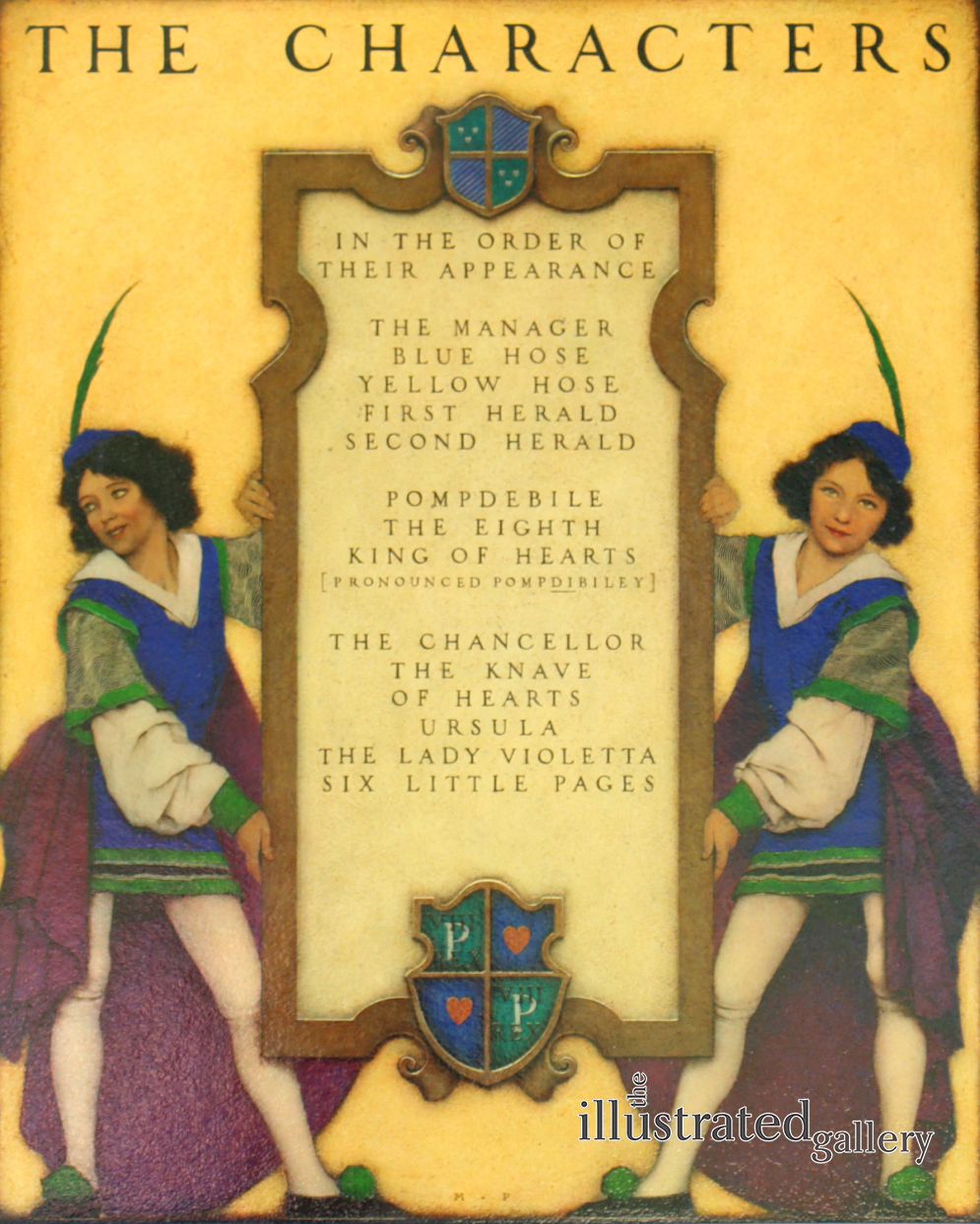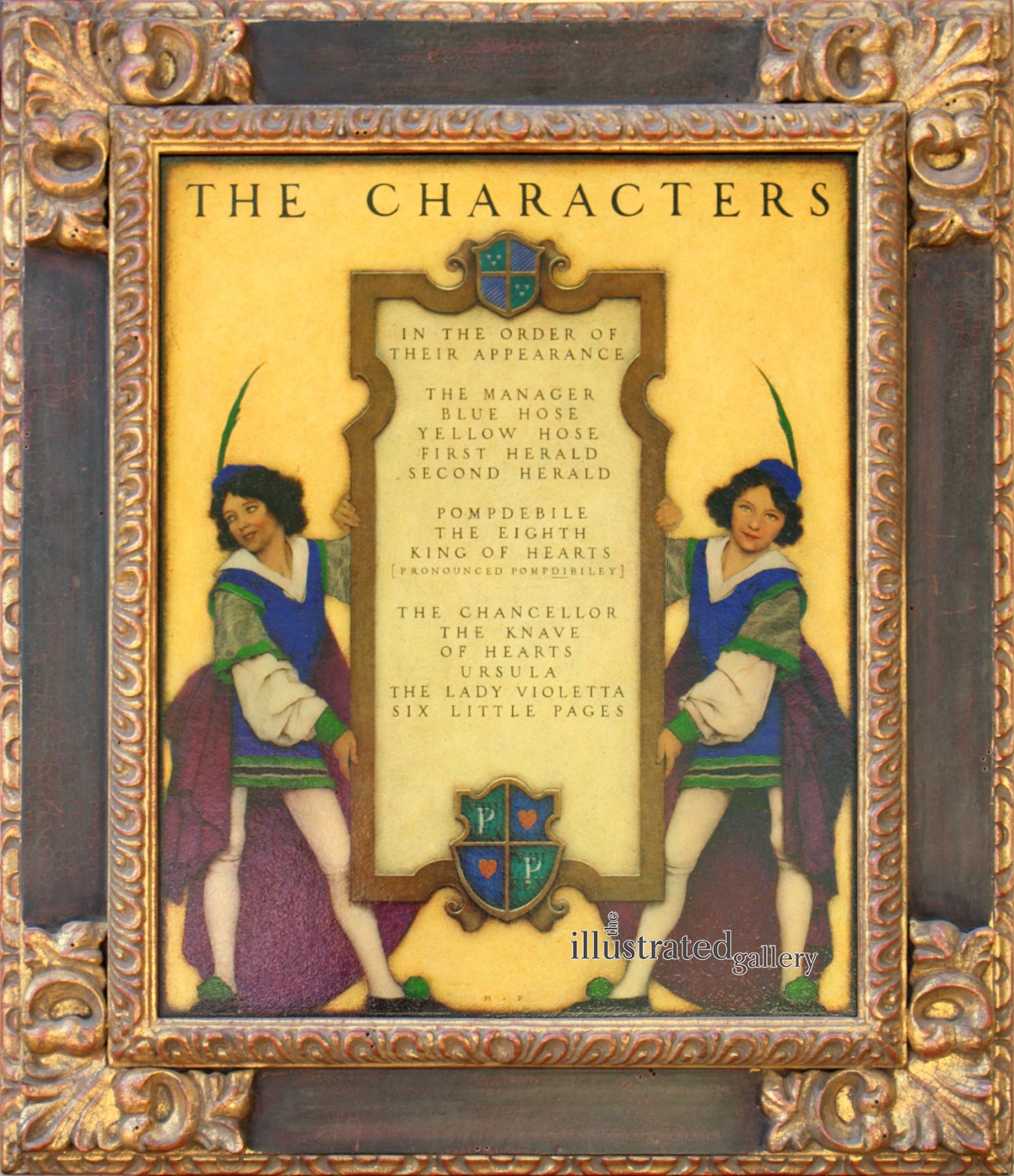"The Knave of Hearts: List of Characters" Lot no. 2545
By Maxfield Parrish (1870-1966)
1923 (Estimated)
20.13" x 16.38", Framed 26.00" x 23.00"
Oil on Board
Signed
REQUEST PRICE
PURCHASE REQUEST
Maxfield Parrish’s popularity as an illustrator began with his early work for magazine publishers. An Easter 1895 cover for Harper’s Bazaar, one of the leading publications of the day, was followed by a successful foray into book illustration beginning in 1897 when Parrish completed illustrations for Frank Baum’s Mother Goose in Prose. His unique style and vivid imagination were well suited to illustrating children’s literature and resulted in numerous commissions. The List of Characters is one of 26 paintings, which appeared as an illustration in Louise Saunders' book, The Knave of Hearts. Lawrence S. Cutler and Judy Goffman Cutler write, “The last book Parrish illustrated, The Knave of Hearts (1924), was his masterpiece. When Parrish discovered this children’s play, he proposed an illustrated edition to Scribner’s, to which the publisher enthusiastically agreed …It was written by Louise Saunders, who was the wife of Maxwell Evarts Perkins of Scribner’s, an important editor in the 20th century and discoverer of authors Thomas Wolfe, Ernest Hemingway, F. Scott Fitzgerald and others. The couple were summer residents at Cornish and close friends of the Parrishes” (Maxfield Parrish and the American Imagists, Edison, New Jersey, 2004, p. 172). According to Coy Ludwig, “The artist’s enthusiasm was shared by the publisher, who requested sketches or more precise information upon which to base a cost analysis, as final approval could not be given until the costs were estimated. Parrish prepared an elaborate dummy or mock-up of the proposed publication, complete with watercolor sketches of the illustrations, and sent it to the publisher early in 1921 …The twenty-six paintings for The Knave of Heartswere executed within three years, and the book, a sumptuous production, was published on October 2, 1925… The volume, selling for ten dollars, was packaged in a telescoping box, decorated with one of the illustrations from the book. Coinciding with the publicity surrounding the release of the book, a major exhibition of fifty paintings by the artist was held during November and December at Scott and Fowles, a gallery in New York …The release of the new book and exhibition at Scott and Fowles, coupled with the previous year’s great popular success of his painting Daybreak (Private Collection), made 1924 and 1925 two of the most remunerative years in Parrish’s career” (Maxfield Parrish, New York, 1973, p. 48).
Exhibitions:
New York, Scott & Fowles, An Exhibition of Paintings by Maxfield Parrish, November-December 1925 (probably)Chadds Ford, Pennsylvania, Brandywine River Museum, Maxfield Parrish: Master of Make Believe, June-September 1974, no. 35, p. 27
Literature:
Paul W. Skeeters, Maxfield Parrish, The Early Years, 1893-1930, Secaucus, New Jersey, 1973, p. 256, illustrated in color p. 257Laurence S. Cutler, Judy Goffman Cutler, and the National Museum of American Illustration, Maxfield Parrish and the American Imagists, Edison, New Jersey, 2004, p. 215, illustrated in color JVJ Publishing, Jim Vadeboncoeur; The Vadeboncoeur Collection of Images, Palo Alto, CA. Issue#13, Fall 2014
Explore related art collections: Books / $100,000 & Above / 1920s / Women as Subjects / Fairy Tale
See all original artwork by Maxfield Parrish
ABOUT THE ARTIST
To behold the work of American illustrator Maxfield Parrish (1870–1966) is to enter into a fantasy world of ethereal beauty. Whether a book illustration, magazine cover, painting or mural commission, his flawlessly rendered subjects and fairy-tale settings are infused with a sense of mythical beauty unmatched by any artist in his wake
A Unique Approach
The magic and sublime spirit of Parrish’s work is the result of his unique approach to painting. He began with a white base which served to illuminate the image from the first layer up through to the last. Repeated layering of varnish on the surface of the pigment heightened the vibrancy of his colors, yielding shades like the famous "Parrish blue," a rich cobalt that is now indelibly associated with the artist. This singular technique allowed Parrish to convey textures and patterns with the intense detail and saturation of color that became trademarks of his best works.
This May, a museum-quality collection of 11 works by Maxfield Parrish pay tribute to the superior talent and unique vision of this seminal artist. A leading highlight of the collection is Sing a Song of Six Pence, measuring over 13 feet long and painted as a mural for the hotel bar of the Sherman House in Chicago, Illinois. Parrish began his career painting a mural of Old King Cole for the University of Pennsylvania in 1894, and was immediately recognized for his ability to render exquisite detail on a monumental scale. He often projected photographic images and then painted directly on the surface of his murals, which may account for the veracity of the features displayed in this work.



